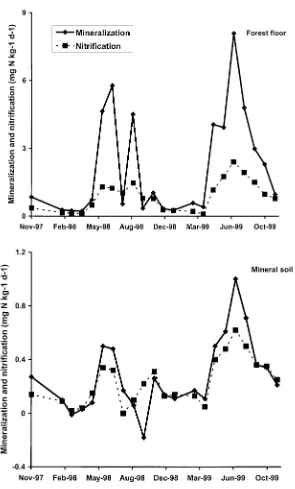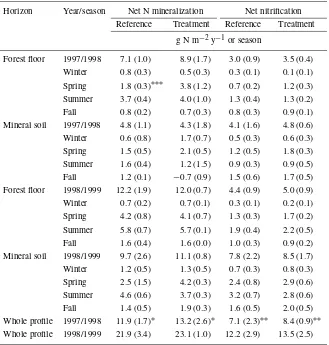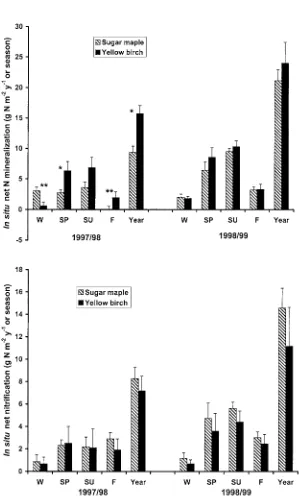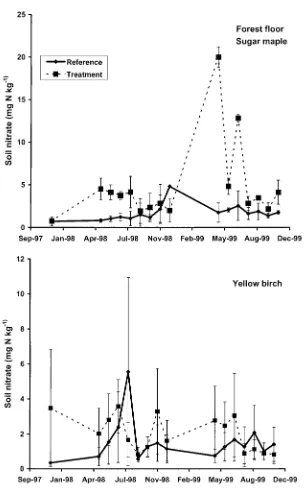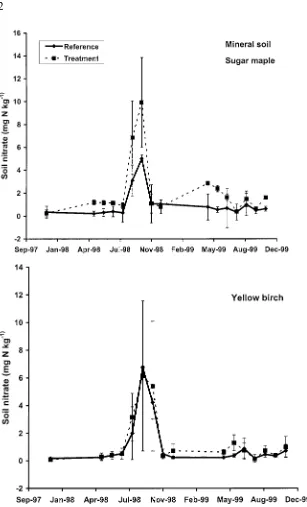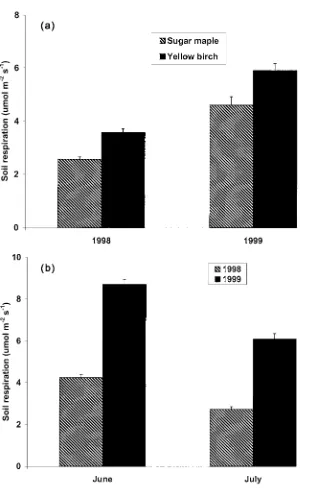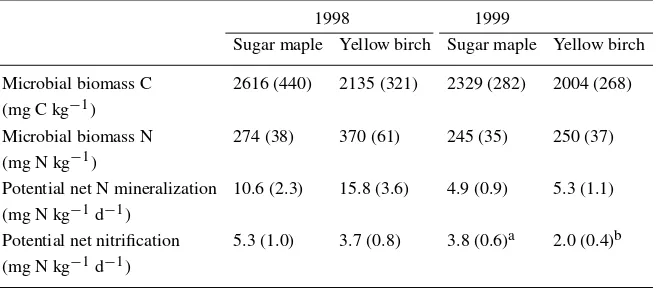© 2001Kluwer Academic Publishers. Printed in the Netherlands.
Effects of mild winter freezing on soil nitrogen and
carbon dynamics in a northern hardwood forest
PETER M. GROFFMAN1∗
, CHARLES T. DRISCOLL2, TIMOTHY J. FAHEY3, JANET P. HARDY4, ROSS D. FITZHUGH2& GERALDINE L.
TIERNEY3
1Institute of Ecosystem Studies, Box AB, Millbrook, NY 12545, U.S.A.;2Syracuse University,
Department of Civil and Environmental Engineering, Syracuse, NY 13244, U.S.A.;3Cornell University, Department of Natural Resources, Ithaca, NY 14853, U.S.A.;4U.S. Army, Cold Regions Research and Engineering Laborary, Hanover, NH 03755, U.S.A.
(∗author for correspondence, e-mail: [email protected])
Key words:climate change, denitrification, microbial biomass, mineralization, nitrification, northern hardwood forest, soil freezing
Abstract. Overwinter and snowmelt processes are thought to be critical to controllers of nitrogen (N) cycling and retention in northern forests. However, there have been few measure-ments of basic N cycle processes (e.g. mineralization, nitrification, denitrification) during winter and little analysis of the influence of winter climate on growing season N dynamics. In this study, we manipulated snow cover to assess the effects of soil freezing onin siturates of N mineralization, nitrification and soil respiration, denitrification (intact core, C2H2 –
based method), microbial biomass C and N content and potential net N mineralization and nitrification in two sugar maple and two yellow birch stands with reference and snow manipu-lation treatment plots over a two year period at the Hubbard Brook Experimental Forest, New Hampshire, U.S.A. The snow manipulation treatment, which simulated the late development of snowpack as may occur in a warmer climate, induced mild (temperatures >−5◦C) soil freezing that lasted until snowmelt. The treatment caused significant increases in soil nitrate (NO−3) concentrations in sugar maple stands, but did not affect mineralization, nitrification, denitrification or microbial biomass, and had no significant effects in yellow birch stands. Annual N mineralization and nitrification rates varied significantly from year to year. Net mineralization increased from∼12.0 g N m−2y−1in 1998 to∼22 g N m−2y−1in 1999 and nitrification increased from∼8 g N m−2y−1in 1998 to∼13 g N m−2y−1in 1999.
Denitrification rates ranged from 0 to 0.65 g N m−2y−1. Our results suggest that mild soil
Introduction
Overwinter processes are critical controllers of drainage loss of elements from temperate forest ecosystems (Rascher et al. 1987; Likens & Bormann 1995; Stottlemyer & Toczydlowski 1996, 1999; Brooks et al. 1999). Despite this importance, there have been few measurements of biogeochemical processes during winter, and very few studies of the factors that influence spatial and temporal variation in these processes. Previous studies have demonstrated that root and microbial processes are surprisingly active in cold (0–5 ◦C) and even frozen soils and that a significant portion (20–50%) of ecosystem C and N cycling and soil-atmosphere trace gas fluxes can occur during winter (Vogt et al. 1986; Coxson & Parkinson 1987; Taylor & Jones 1990; Sommerfeld et al. 1993; Clein & Schimel 1995; Melloh & Crill 1995; Hobbie & Chapin 1996; Brooks et al. 1997; Alm et al. 1999). Overwinter processes appear to be highly variable, subject to perturbation (e.g. climate change), and to strongly influence nutrient losses during the subsequent growing season (Mitchell et al. 1996; Brooks et al. 1998; Williams et al. 1998; Groffman et al. 1999; Hardy et al. 1999).
The mechanisms of N retention in forested watersheds have been an important focus of research in ecosystem ecology. There is great current interest in the ability of forest ecosystems to continue to retain N despite high rates of atmospheric deposition and/or fertilization (Aber et al. 1989; Foster et al. 1997; Fenn et al. 1998; Lovett et al. 2000; Magill et al. 2000). Overwinter and snowmelt processes may be critical to high rates of N reten-tion in northern forests (Mitchell et al. 1996; Murdoch et al. 1998; Brooks et al. 1999). However, there have been very few measurements of basic N cycle processes (e.g. mineralization, nitrification, denitrification) during winter and very little analysis of the influence of winter climate on growing season N dynamics.
The Hubbard Brook Experimental Forest (HBEF) in the White Moun-tains of New Hampshire, U.S.A. (www.hbrook.sr.unh.edu) has been the site of numerous biogeochemical studies. Much of the work at HBEF has focused on whole ecosystem element budgets of northern hardwood forest water-sheds. While the importance of snowpack dynamics and winter climate on these budgets has been noted (Likens & Bormann 1995), there have been few detailed studies or experimental manipulations focused on overwinter processes at this site. Moreover, there have been relatively few intensive studies of in situN cycle processes (e.g. mineralization, nitrification, deni-trification) at the HBEF (Likens et al. 1969; Bormann et al. 1977; Melillo 1977; Federer 1983; Duggin et al. 1991; Christ et al. 1995; Bohlen et al. 2001). Interest in these processes in the soils at HBEF has increased in recent years as rates of atmospheric deposition have increased, forest biomass has ceased aggrading and stream nitrate (NO−3) exports have decreased (Likens et al. 1996; Aber & Driscoll 1997).
In this study, we utilized a snow cover manipulation to assess the effects of soil freezing onin siturates of N mineralization, nitrification and soil respira-tion, intact core-based measurements of denitrification and seasonal levels of microbial biomass C and N content and potential net N mineralization and nitrification in two sugar maple and two yellow birch stands at the HBEF, over two years. The snow manipulation treatment, which was designed to simulate the late development of snowpack as may occur in a warmer climate, and its effects on fine root dynamics, soil solution chemistry and trace gas fluxes are described elsewhere (Groffman et al. 1999; Neilsen et al. 2001; Hardy et al. this issue; Fitzhugh et al. this issue; Tierney et al. this issue). The specific objectives of this study were to (1) evaluate the effects of snow manipula-tion on winter and summer soil N dynamics and (2) describe seasonal and annual patterns of net N mineralization, nitrification, soil respiration and denitrification in soils beneath two of the dominant canopy tree species at HBEF.
Methods
Experimental design
in 1938. Soils are shallow (75–100 cm), acidic (ph 3.9) Typic Haplorthods developed from unsorted basal tills.
The experimental design for the snow manipulation study consisted of 8, 10 × 10-m plots. The plots were located within four stands, two of each species (80% dominance by the target species), with one snow reduction (treatment) and one reference plot in each stand. In the fall and winter of 1996, we cleared minor amounts of understory vegetation from all (both treatment and reference) plots (to facilitate shoveling). We then installed soil solution samplers (zero tension lysimeters), thermistors for soil temperature monitoring, soil water content monitors (time domain reflectometers), soil atmosphere sampling probes, minirhizotron access tubes and trace gas flux measurement chambers as described elsewhere (Groffman et al. 1999; Hardy et al. this issue; Fitzhugh et al. this issue; Tierney et al. this issue). All plots were equipped with dataloggers to allow for continuous monitoring of soil moisture and temperature. All instruments were installed in fall 1996 to allow for any installation-related disturbance effects to subside before the treatment was introduced in fall/winter of 1997.
From late November until early February in the winters of 1997/1998 and 1998/1999 the treatment plots were kept snow-free to simulate a reduced snowfall, while the reference plots accumulated snow at ambient rates. As soon as practical after each snowfall, shovels were used to clear the treatment plots of the new snow. We allowed a few cm of snow to compact on the ground to protect plot cables and the forest floor from shovel damage, and to increase the albedo of the forest floor to aid in soil freezing.
From fall 1997–fall 1999, we sampled lysimeters, measured trace gas fluxes and collected video images for roots at weekly to monthly intervals. Thermistors measured soil temperatures every 0.1 m to a depth of 0.5 m and snow temperatures every 0.2 m to a height of 0.8 m. We measured snow and soil temperatures every 5 minutes and data were stored as hourly averages on a datalogger. Every two weeks, we made manual measurements of snow depth variability (n= 100), snow density and snow water equivalence at two sites. Results of these measurements are reported elsewhere in this issue.
In situnet N mineralization and nitrification
Net N mineralization and nitrification were measured using anin situintact core method (Robertson et al. 1999). During the growing season, 10, 2-cm diameter intact cores were removed from each plot. Five of the cores were returned to the laboratory for extraction (2 N KCl) of inorganic N (NH+
4
and NO−
3) and five were returned to the plot for in situ incubation. Cores
injection analyzer. Net N mineralization rates were calculated as the accumu-lation of total inorganic N over the course of the incubation. Net nitrification rates were calculated as the accumulation of NO−
3 over the course of the
incubation. Values were converted to an areal basis (g N m−2) using forest
floor depth and bulk density values and mineral soil (to 10 cm) density values from Bohlen et al. (2001).
For overwinter incubation, approximately 25 cores were collected in late November. Five of these cores were returned to the laboratory for imme-diate extraction and 20 were left to incubate in situ. Five cores were then harvested at approximately 4 wk intervals (January, February, March, April). Rates of N mineralization and nitrification were calculated from the month-to-month accumulation of total inorganic N and NO−
3 in the incubated cores.
The November samples served as the ‘initial’ extractions for all overwinter months (December through March) due to the difficulty of sampling frozen soil (Stottlemyer & Toczydlowski 1996).
Soil respiration
Soil respiration rates were measuredin situ using the Li-CorTM 6400 port-able soil CO2 flux measurement system. Permanent chamber bases (10 cm
diameter, 10 per plot) were placed in all plots in spring 1998. Rates were measured at approximately monthly intervals from June through November 1998, and from April through July 1999.
Denitrification
All cores that were collected for in situ N mineralization and nitrification analyses were also assayed for denitrification using an acetylene (C2H2
)-based intact core method (Groffman et al. 1999). Cores were brought back to the laboratory, amended with 10 kPa of acetylene and incubated at laboratory temperature for 6 hr. Gas samples were taken at 2 and 6 hr and stored in evacuated glass tubes until analysis for nitrous oxide (N2O) concentrations
Microbial biomass C and N, and potential net N mineralization and nitrification
Microbial biomass C and N content were measured using the chloroform-fumigation incubation method (Jenkinson & Powlson 1976), twice in 1998 (April, July) and three times in 1999 (April, July, October). Samples were fumigated to lyse microbial cells, inoculated with fresh soil and incubated for 10 days at 25◦C at field moisture content. Carbon dioxide and NH+
4 released
during the incubation were assumed to be directly proportional to the amount of C and N in the microbial biomass of the original sample. Carbon dioxide (CO2) was measured by thermal conductivity gas chromatography and NH+4
was quantified colorometrically after KCl extraction as described above. A proportionality constant (kc = 0.41) was used to calculate biomass C from
the CO2 produced during the incubation. No proportionality constant was
used for biomass N. Biomass N was equivalent to the flush of inorganic N produced following fumigation and incubation.
Statistical analysis
Overall treatment and vegetation effects were assessed with two-way repeated measures analysis of variance (with interactions) of plot means from each sampling date with treatment and vegetation as main effects. Seasonal values were computed by taking the mean of all sampling dates within a season (December–March = winter, April–June = spring, July–September = summer, October–November = fall) and multiplying by either 120 (winter) or 81.67 days (spring, summer, fall). Annual values were computed by summing the seasonal values. Seasonal and annual values were analyzed by two-way analysis of variance (with interactions) without repeated measures. The Statistical Analysis System (SAS 1989) was used for all analyses.
Results
Figure 1. Temporal patterns ofin situnet mineralization and nitrification in the forest floor (top panel) and mineral soil (bottom panel) from fall 1997–fall 1999. Values are the mean of two sugar maple and two yellow birch sands with reference and treatment plots (n= 8 for each
Table 1. Seasonal and annualin situnet N mineralization and nitrification rates in forest floor and mineral soil of reference and treatment plots in 1997/1998 and 1998/1999. Seasonal values were produced by computing a mean seasonal rate from 2–4 sample dates in each season and then multiplying by either by 120 (winter) or 81.67 (spring, summer, fall) days. Values are mean (standard error) for two sugar maple and two yellow birch stands with treatment and reference plots (n= 4). Annual values are the sum of the seasonal values.∗,
∗∗
,∗∗∗indicate significant differences between treatments or years atp <0.01, 0.05, 0.10
respectively
Horizon Year/season Net N mineralization Net nitrification Reference Treatment Reference Treatment
g N m−2y−1or season
Forest floor 1997/1998 7.1 (1.0) 8.9 (1.7) 3.0 (0.9) 3.5 (0.4) Winter 0.8 (0.3) 0.5 (0.3) 0.3 (0.1) 0.1 (0.1) Spring 1.8 (0.3)∗∗∗ 3.8 (1.2) 0.7 (0.2) 1.2 (0.3) Summer 3.7 (0.4) 4.0 (1.0) 1.3 (0.4) 1.3 (0.2) Fall 0.8 (0.2) 0.7 (0.3) 0.8 (0.3) 0.9 (0.1) Mineral soil 1997/1998 4.8 (1.1) 4.3 (1.8) 4.1 (1.6) 4.8 (0.6) Winter 0.6 (0.8) 1.7 (0.7) 0.5 (0.3) 0.6 (0.3) Spring 1.5 (0.5) 2.1 (0.5) 1.2 (0.5) 1.8 (0.3) Summer 1.6 (0.4) 1.2 (1.5) 0.9 (0.3) 0.9 (0.5) Fall 1.2 (0.1) −0.7 (0.9) 1.5 (0.6) 1.7 (0.5) Forest floor 1998/1999 12.2 (1.9) 12.0 (0.7) 4.4 (0.9) 5.0 (0.9) Winter 0.7 (0.2) 0.7 (0.1) 0.3 (0.1) 0.2 (0.1) Spring 4.2 (0.8) 4.1 (0.7) 1.3 (0.3) 1.7 (0.2) Summer 5.8 (0.7) 5.7 (0.1) 1.9 (0.4) 2.2 (0.5) Fall 1.6 (0.4) 1.6 (0.0) 1.0 (0.3) 0.9 (0.2) Mineral soil 1998/1999 9.7 (2.6) 11.1 (0.8) 7.8 (2.2) 8.5 (1.7) Winter 1.2 (0.5) 1.3 (0.5) 0.7 (0.3) 0.8 (0.3) Spring 2.5 (1.5) 4.2 (0.3) 2.4 (0.8) 2.9 (0.6) Summer 4.6 (0.6) 3.7 (0.3) 3.2 (0.7) 2.8 (0.6) Fall 1.4 (0.5) 1.9 (0.3) 1.6 (0.5) 2.0 (0.5) Whole profile 1997/1998 11.9 (1.7)∗ 13.2 (2.6)∗ 7.1 (2.3)∗∗ 8.4 (0.9)∗∗ Whole profile 1998/1999 21.9 (3.4) 23.1 (1.0) 12.2 (2.9) 13.5 (2.5)
Yellow birch had higher rates of N mineralization than sugar maple, but only in 1999 (Figure 2). There were no significant species effects on nitrification (Figure 2).
Table 2. Annual denitrification rates in 1997/1998 and 1998/1999. Values are derived from the means of 7 sample dates in 1998 and 10 sample dates in 1999 for two sugar maple and two yellow birch stands with treatment and reference plots. Mean rates were extrapolated to an annual value, assuming 274 days of activity per year
Year Sugar maple Yellow birch
Reference Treatment Reference Treatment
g N m−2y−1
1998 0.14 (0.04) 0.53 (0.34) 0.14 (0.04) 0.09 (0.04) 1999 0.65 (0.37) 0.12 (0.13) −0.59 (0.43) 0.69 (0.36)
(Table 1). Between 7 and 15% of annual whole soil profile mineralization and nitrification occurred during winter (December–March). Between 40 and 64% of total soil profile mineralization activity took place in the forest floor.
The treatment increased soil NO−
3 concentrations in both the forest floor
(Figure 3) and mineral soil (Figure 4), but the overall effect was only signifi-cant (p < 0.10) in the forest floor of the sugar maple stands. Soil NO−3 concentrations were higher (p <0.01) in sugar maple than yellow birch soils, but the overall effect was only significant for treated plots, in the forest floor. Soil NH+4 and total inorganic N (NO−3 plus NH+4) concentrations were not affected by treatment or vegetation type.
Soil respiration rates were not affected by the snow manipulation treat-ment (data not presented). However, rates were higher (p <0.01) in yellow birch than sugar maple, in both 1998 and 1999 (Figure 5(a)). Respiration rates were higher (p <0.01) in June and July of 1999 than in the same months in 1998 (Figure 5(b)).
There were no significant treatment, vegetation or seasonal effects on rates of denitrification in 1998 (Table 2). In 1999, there was a significant (p < 0.05) treatment effect within the yellow birch stands and a significant (p < 0.05) vegetation effect within the control treatment. These differences were due to negative denitrification rates in yellow birch stands during summer, which were likely due to a methodological artifact (Groffman et al. 1999). Denitrification rates ranged from 0–0.65 g N m−2y−1. Due to lack of seasonal
effects, only annual means are presented in Table 2.
Figure 2. Seasonal and annual in situ net N mineralization (top panel) and nitrification (bottom panel) in the forest floor and mineral soil (0–10 cm) of sugar maple and yellow birch stands from fall 1997 to fall 1999. Values are the mean (with standard error) of two reference and two treatment plots per date (n= 4 four each point).∗,∗∗indicates a significant difference
Figure 4. Soil nitrate in the mineral soil (0–10 cm) of reference and treatment plots in sugar maple (top panel) and yellow birch (bottom panel) stands from fall 1997–fall 1999. Values are the mean (with standard error) of two reference and two treatment plots per date (n= 4 for
Table 3. Microbial biomass C and N in reference and treatment plots in two sugar maple and two yellow birch stands in 1998 and 1999. Values are the mean (with standard error) of four reference and four treatment plots sampled at two dates (April, July) in 1998 and three dates (April, July, October) in 1999
1998 1999
Reference Treatment Reference Treatment
Microbial biomass C 2359 (386) 2376 (387) 2162 (281) 2171 (273) (mg C kg−1)
Microbial biomass N 304 (48) 341 (57) 251 (36) 244 (36) (mg N kg−1)
Potential net N mineralization 12.5 (2.9) 13.9 (3.2) 5.1 (1.0) 5.1 (1.0) (mg N kg−1d−1)
Potential net nitrification 4.2 (0.9) 4.9 (0.9) 2.9 (0.6) 2.9 (0.5) (mg N kg−1d−1)
Table 4. Microbial biomass C and N in sugar maple and yellow birch stands in 1998 and 1999. Values are the mean (with standard error) of both treatment and reference plots for two stands for each vegetation type sampled at two dates (April, July) in 1998 and three dates (April, July, October) in 1999. Different superscripts indicate statistically significant (p <
0.05) differences between vegetation types
1998 1999
Sugar maple Yellow birch Sugar maple Yellow birch
Microbial biomass C 2616 (440) 2135 (321) 2329 (282) 2004 (268) (mg C kg−1)
Microbial biomass N 274 (38) 370 (61) 245 (35) 250 (37) (mg N kg−1)
Potential net N mineralization 10.6 (2.3) 15.8 (3.6) 4.9 (0.9) 5.3 (1.1) (mg N kg−1d−1)
Potential net nitrification 5.3 (1.0) 3.7 (0.8) 3.8 (0.6)a 2.0 (0.4)b (mg N kg−1d−1)
Discussion
Snow manipulation effects
The snow manipulation treatment produced mild, but persistent soil freezing in both 1997/1998 and 1998/1999. Soils froze to at least 10 cm depth by mid January and stayed frozen through mid March, but soil temperatures seldom decreased below −4 ◦C (Hardy et al. this issue). The treatment reduced infiltration and soil moisture by approximately 15% during snowmelt but had no effect on these variables during the growing season (Hardy et al. this issue). The treatment significantly increased fine root mortality in spring and increased fine root production during summer in both years (Tierney et al. this issue). There were marked increases in soil solution losses of inorganic N and P, dissolved organic C and N and base cations and increases in the acidity of drainage water in treatment plots (Fitzhugh et al. this issue; Fitzhugh 2000).
Treatment effects on soil N cycle processes were complex and surprising in several ways. We originally hypothesized that soil freezing would result in root and microbial mortality, which would lead to increases in hydrologic and gaseous N losses as the dead root and microbial cells were decomposed, mineralized and nitrified. However, soil temperatures in the treatment plots, which seldom decreased below −4 ◦C, were less severe than those shown to directly cause root or microbial mortality in short-term laboratory exper-iments (Sakai & Larcher 1987; Edwards & Cresser 1992). The treatment did increase fine root mortality, perhaps due to the duration of the freeze, the cycles of freezing and thawing, or via physical disturbance due to ice expansion, formation of ice lenses and/or capillary water movement asso-ciated with frost heaving. The N release assoasso-ciated with fine root mortality (Tierney et al. this issue) was a significant fraction of the hydrologic N loss reported by Fitzhugh et al. (this issue) at some sites. However, the fact that we did not observe an increase in N mineralization rates in the treatment plots suggests that root mortality was not the only source of N loss from the treatment. Other processes, such as reduced N uptake by fine roots and physical disturbance of root-soil-microbial interactions, likely led to reduced competition for inorganic N and the increases in soil NO−
3 concentrations
and NO−
3 leaching that we observed. Mild freezing appears to disrupt the
normally tight coupling between mineralization, immobilization and plant uptake (Pawluk 1988; Miller & Jastrow 1990). This coupling is considered to be an important controller of N losses from forest ecosystems (Bormann & Likens 1979; Mullen et al. 1998).
is predicted to occur as the climate warms due to increased atmospheric CO2levels (Cooley 1990). These effects are distinct from the more dramatic
root and microbial mortality-induced freeze effects that we originally set out to study. However, mild freeze events are more likely to be increasingly common than severe freeze events in a warmer world.
Mild freeze effects may be highly variable and mechanistically complex. In contrast to our results, Boutin and Robitaille (1994) found that superficial frost (induced by a one week snow removal treatment) had no effect on NO−
3
leaching, while deep frost (induced by full season snow removal) caused extensive tree mortality and large increases in NO−
3 leaching. It is possible
that their superficial frost treatment was too mild to cause physical disruption of soil-root-microbial interactions.
While we did not observe any treatment effects on microbial biomass, Brooks et al. (1997) and Lipson et al. (2000) found that microbial biomass was highly variable, and functioned as an important N ‘buffer’ during snow-melt. They observed greater biomass at sites with deep continuous snow cover where soils remained thawed, and lower biomass at sites with shallow discontinuous snow cover that had frozen soils. We did not sample frequently enough during snowmelt to detect dynamic temporal changes in microbial biomass as these investigators did. Also, temperatures in their studies were lower (−6 to−10◦C), possibly low enough to cause microbial mortality.
Similar to microbial biomass, rapidly changing conditions during snow-melt may have contributed to our inability to detect a treatment effect on rates of denitrification. Nyborg et al. (1997) found very high rates of denitri-fication (over 20 kg N ha−1) in a 10-day period just around snowmelt. Future
studies of freeze events should consider very high frequency (e.g. daily or twice a week) sampling for both microbial biomass and denitrification during snowmelt and/or soil thaw.
Our results suggest that forest species composition will be an important regulator of the response of forest ecosystems to increased freeze frequency. Sugar maple treatment plots had higher soil NO−
3 concentrations and higher
environmental change (Tilman 1998; Lovett & Rueth 1999; Nielsen et al. submitted).
In a more basic sense, our study raises questions about the importance of freeze frequency as a regulator of the nature and extent of N cycling and loss in forest ecosystems. We suggest that freeze frequency should be considered in large-scale functional evaluations of ecosystems, much like the distinctions that are made between deciduous and evergreen forests or between temperate and tropical forests. Forests with soils that freeze frequently, e.g. those in areas south of our site with much less snow cover, may have inherently different patterns of element cycling, storage and loss than those that do not.
The importance of overwinter activity
Winter activity proved to be less important than we originally hypothe-sized. Given that snow covered soils generally do not freeze, and previous studies suggesting that a high percentage (20–50%) of C and N cycling occur overwinter (see citations in Introduction), we were surprised that only between 5 and 15% of annual mineralization and nitrification activity took place during winter. Our results are similar to those obtained by Hill and Shackleton (1989), Boone (1992), Stottlemyer and Toczydlowski (1996) and Lamontagne (1998), who also found very low rates of N mineralization and/or nitrification during winter in temperate forest ecosystems.
In contrast to our results, Brooks et al. (1996) found that overwinter N mineralization in alpine tundra at Niwot Ridge, Colorado U.S.A. was greater than growing season activity (2–6 g N m−2 in winter vs. 0.9–1.2 g N m−2
in summer). Williams et al. (1998) found that denitrification N gas loss was greater than annual atmospheric input at Niwot Ridge. It is important to note that summer activity at Niwot Ridge is likely limited by low soil moisture and that annual rates of N cycle possesses there are low relative to HBEF.
Similar to Brooks et al. (1996), DeVito et al. (1999), working in maple/beech/poplar stands in Ontario, Canada more similar to HBEF than Niwot Ridge, found 49% of annual mineralization and 23% of annual nitri-fication took place overwinter. They suggest that methodological differences (e.g. leaving overwinter cores in the ground all winter) may lead to underes-timation of rates. There is a clear need for more research, with better methods, to determine the factors controlling variation in overwinter activity in forest ecosystems.
Annual fluxes and variability
whole-watershed N analyses. Annual rates of N mineralization in 1998 (11.9–13.2 g N m−2y−1) were similar to those reported for other, similar forest ecosystems
(Melillo 1977; Scott & Binkley 1997; Reich et al. 1997; DeVito et al. 1999; Goodale et al. 2001), but the rates in 1999 (around 23 g N m−2y−1) are high
compared to other studies. The fact that our estimates include both the forest floor and the top 10 cm of the mineral soil, while many studies ignore, or include variable amounts of mineral soil, may account for our higher values. In our studies, the mineral soil accounted for from 40 to 60% of the total mineralization and nitrification activity. The distribution of activity within the soil profile that we observed is similar to that reported by Federer (1983) and Fisk and Fahey (1990) for HBEF soils.
The nitrification rates that we measured (from 7–13.5 g N m−2 y−1)
are high relative to previous work at Hubbard Brook (Melillo 1977) and at other similar forest sites in northeastern North America (Campbell et al. 2000; Goodale et al. 2001). Nitrification as a percentage of N mineraliza-tion was approximately 60% of mineralizamineraliza-tion, which is also high compared to Melillo’s (1977) observations from similar forests at HBEF. It is not surprising that nitrification has increased at HBEF from the mid-1970’s to the late 1990’s as these forests have aged and stopped aggrading (Bormann & Likens 1979).
Our estimates of annual denitrification ranged from negligible, which was expected for these forests (Bowden 1986; Barton et al. 1999), to more than 0.6 g N m−2y−1. These higher rates are significant relative to atmospheric
depos-ition (Lovett & Rueth 1999) and stream NO−
3 export (Likens & Bormann
1995) at HBEF and suggest that denitrification may be a more important flux in these forests than previously thought.
Inter-annual variation in N mineralization and nitrification appears to be important in northern hardwood forest ecosystems and is clearly worthy of further study. Mineralization and nitrification increased in both the forest floor and mineral soil from 1998 to 1999, despite the fact that soils were generally drier during June, July and much of August of 1999. Total soil profile nitrification changed less than mineralization from year to year. Respiration rates were also higher in 1999 than 1998, suggesting a general increase in microbial activity. Other sites at Hubbard Brook also showed high in situ N mineralization rates in 1999 compared to 1998 (Houlton et al. submitted), suggesting that the increase was not an artifact caused by plot sampling and/or disturbance. In contrast toin situ mineralization and respiration, microbial biomass C and N and potential net N mineralization and nitrification were lower in 1999 than 1998.
significant inter-annual variation in microbial processes in soils at HBEF. Hughes and Fahey (1994) reported significant inter-annual variation in litter-fall N at HBEF. In contrast, DeVito et al. (1999) observed very little annual variation in mineralization and nitrification over two years of measurement in beech/maple/poplar stands in Ontario, Canada (approximately 11 g N m−2
y−1 in both years), with nitrification at 58% of N mineralization. Our data
suggest that there are complex internal N dynamics in northern hardwood ecosystems that may cause significant inter-annual variation in ecosystem productivity, delivery of NO−3 and other ions to streams and soil: atmosphere trace gas fluxes. The factors regulating these dynamics should be explored in future research.
Acknowledgements
The authors thank Adam Welman and Jason Demers for excellent field, laboratory and data analysis work. We also thank Ann Gorham, Alan Lore-fice, Sibylle Otto and Dirk Koopmans for laboratory and data analysis support, Wayne Martin and Scott Nolan for help with site location and estab-lishment and two anonymous reviewers for helpful comments. This research was supported by NSF Grant DEB-9652678, which was a product of the inter-agency program on Terrestrial Ecosystems and Global Change (TECO). This research was conducted at the Hubbard Brook Experimental Forest, which is owned and operated by the Northeastern Research Station, USDA Forest Service, Newtown Square, PA. This paper is a contribution to the Hubbard Brook Ecosystem Study.
References
Aber JD, Nadelhoffer KJ, Steudler P & Melillo JM (1989) Nitrogen saturation in northern forest ecosystems. Bio. Sci. 39: 378–386
Aber JD & Driscoll CT (1997) Effects of land use, climate variation and N deposition on N cycling and C storage in northern hardwood forests. Biogeochem. Cycles 11: 639–648 Alm J, Saarnio AJ, Nykanen H, Silvola J & Martikainen PJ (1999) Winter CO2, CH4and N2O
fluxes on some natural and drained boreal peatlands. Biogeochem. 44: 163–186
Barton L, McLay CDA, Schipper LA & Smith CT (1999) Annual denitrification rates in agricultural and forest soils: a review. Aust. J. Soil Res. 37(6): 1073–1093
Bohlen PJ, Groffman PM, Fahey TJ, Driscoll CT & Siccama TG (2001) Plant-soil-microbial interactions in a northern hardwood forest. Ecology 82: 965–978
Bormann FH, Likens GE & Melillo JM (1977) Nitrogen budget for an aggrading northern hardwood forest ecosystem. Sci. 196: 981–983
Bormann FH & Likens GE (1979) Pattern and Process in a Forested Ecosystem. Springer-Verlag, New York
Boutin R & Robitaille G (1994) Increased soil nitrate losses under mature sugar maple trees affected by experimentally induced deep frost. Can. J. For. Res. 25: 588–602
Bowden WB (1986) Gaseous nitrogen emissions from undisturbed terrestrial ecosystems: An assessment of their impacts on local and global nitrogen budgets. Biogeochem. 2: 249–279 Brooks PD, Williams MW & Schmidt SK (1996) Microbial activity under alpine snwopacks,
Niwot Ridge, Colorado. Biogeochem. 32: 93–113
Brooks PD, Schmidt SK & Williams MW (1997) Winter production of CO2and N2O from
alpine tundra: environmental controls and relationship to inter-system C and N fluxes. Oecologia 110: 403–413
Brooks PD, Williams MW & Schmidt SK (1998) Inorganic nitrogen and microbial biomass dynamics before and during snowmelt. Biogeochem. 43: 1–15
Brooks PD, Campbell DH, Tonnessen KH & Heuer K (1999) Natural variability in N export from headwater catchments: Snow cover controls on ecosystem N retention. Hydrol. Proc. 14–15: 2191–2201
Campbell JL, Eagar C, McDowell WH & Hornbeck JW (2000) Analysis of nitrogen dynamics in the Lye Brook wilderness area, Vermont, U.S.A. Water, Air, Soil Pollut. 122: 63–75 Christ M, Zhang Y, Likens GE & Driscoll CT (1995) Nitrogen retention capacity of a northern
hardwood forest soil under ammonium sulfate additions. Ecol. Appl. 5: 802–812 Clein JS & Schimel JP (1995) Microbial activity of tundra and taiga soils at sub-zero
temperatures. Soil Biol. Biochem. 27: 1231–1234
Cooley KR (1990) Effects of CO2-induced climatic changes on snowpack and streamflow.
Hydrol. Sci. 35: 511–522
Coxson DS & Parkinson D (1987) Winter respiratory activity in Aspen woodland forest floor litter and soils. Soil Biol. Biochem. 19: 49–59
DeVito KJ, Westbrook CJ & Schiff SL (1999) Nitrogen mineralization and nitrification in upland and peatland forest soils in two Canadian Shield catchments. Can. J. For. Res. 29: 1793–1804
Duggin JA, Voigt GK & Bormann FH (1991) Autotrophic and heterotrophic nitrification in response to clear-cutting northern hardwood forest. Soil Biol. Biochem. 8: 779–787 Edwards AC & Cresser MS (1992) Freezing and its effect on chemical and biological
properties of soil. Adv. Soil Sci. 18: 59–79
Federer CA (1983) Nitrogen mineralization and nitrification: Depth variation in four New England forest soils. Soil Sci. Am. J. 47: 1008–1014
Fenn ME, Poth MA, Aber JD, Baron JS, Bormann BT, Johnson DW, Lemly AD, McNutty SG, Ryan DE & Stottlemyer R (1998) Nitrogen excess in North American ecosystems: Predisposing factors, ecosystem responses, and management strategies. Ecol. Appl. 8: 706–733
Finzi AC, van Breemen N & Canham CC (1998) Canopy tree-soil interactions within temperate forests: Species effects on soil carbon and nitrogen. Ecol. Appl. 8: 440–446 Fisk M & Fahey TJ (1990) Nitrification potential in the organic horizon following clearfelling
of northern hardwood forests. Soil Biol. Biochem. 22: 277–279
Fitzhugh RD, Driscoll CT, Groffman PM, Tierney GL, Fahey TJ & Hardy JP (this issue) Effects of soil freezing disturbance on soil solution nitrogen, phosphorus and carbon chemistry in a northern hardwood ecosystem. Biogeochem. 56: 215–238
Foster DR, Aber JD, Melillo JM, Bowden RD & Bazzaz FA (1997) Forest response to disturbance and anthropogenic stress. Biosci. 47: 437–445
Goodale CL & Aber JD (2001) The long-term effects of land-use history on nitrogen cycling in northern hardwood forests. Ecol. Appl. 11: 253–267
Groffman PM, Hardy JP, Nolan S, Driscoll CT, Fitzhugh RD & Fahey TJ (1999) Snow depth, soil frost and nutrient loss in a northern hardwood forest. Hydrol. Proc. 13: 2275–2286 Groffman PM, Holland E, Myrold DD, Robertson GP & Zou X (1999) Denitrification. In:
Robertson GP, Bledsoe CS, Coleman DC & Sollins P (Eds) Standard Soil Methods for Long Term Ecological Research (pp 272–290). Oxford University Press, New York Hardy JP, Albert MR & Marsh P (1999) Snow Hydrology: The Integration of Physical,
Chemical and Biological Systems. John Wiley and Sons, Ltd., Chichester
Hardy JP, Groffman PM, Fitzhugh RD, Henry KS, Welman TA, Demers JD, Fahey TJ, Driscoll CT, Tierney GL & Nolan S (this issue) Snow depth, soil frost and water dynamics in a northern hardwood forest. Biogeochem. 56: 151–174
Hart SC, Binkley D & Perry DA (1997) Influence of red alder on soil nitrogen transformations in two conifer forests of contrasting productivity. Soil Biol. Biochem. 29: 1111–1123 Hill AR & Shackleton M (1989) Soil N mineralization and nitrification in relation to nitrogen
solution chemistry in a small forested watershed. Biogeochem. 8: 167–184
Hobbie SE & Chapin FS (1996) Winter regulation of tundra litter carbon and nitrogen dynamics. Biogeochem. 35: 327–338
Houlton BZ, Driscoll CT, Fahey TJ, Likens GE, Groffman PM, Bernhardt E & Buso D (in preparation) Nitrogen dynamics and loss following a nice storm: Implications for nitrogen limitation to temperate zone forests. Submitted to Ecosystems
Hughes JW & Fahey TJ (1994) Litterfall dynamics and ecosystem recovery during forest development. Forest Ecol. Manag. 63: 181–198
Jenkinson DS & Powlson DS (1976) The effects of biocidal treatments on metabolism in soil V. A method for measuring soil biomass. Soil Biol. Biochem. 8: 209–213
Lamontagne S (1998) Nitrogen mineralization in upland Precambrain Shield catchments: contrasting the role of lichen-covered bedrock and forested areas. Biogeochem. 41: 53–69 Lawrence GB, Lovett GM & Baevsky YH (2000) Atmospheric deposition and watershed nitrogen export along an elevational gradient in the Catskill Mountains, New York. Biogeochem. 50: 21–43
Likens GE, Borman FH & Johnson NM (1969) Nitrification: Importance to nutrient losses from a cutover forested ecosystem. Sci. 163: 1205–1206
Likens GE & Bormann FH (1995) Biogeochemistry of a Forested Ecosystem, Second Edition. Springer-Verlag, New York
Likens GE, Driscoll CT & Buso DC (1996) Long-term effects of acid rain: response and recovery of a forest ecosystem. Sci. 272: 244–245
Lipson DA, Schmidt SK, Russel K & Monson K (2000) Carbon availability and temperature control the post-snowmelt decline in alpine soil microbial biomass. Soil Biol. Biochem. 32: 441–448
Lovett GM & Rueth H (1999) Potential nitrogen mineralization and nitrification in american beech and sugar maple stands along a nitrogen deposition gradient in the northeastern U.S. Ecol. Appl. 9: 1330–1344
Magill AH, Aber JD, Berntson GM, McDowell WH, Nadelhoffer KJ, Melillo JM & Steudler P (2000) Long-term nitrogen additions and nitrogen saturation in two temperate forests. Ecosystems 3: 238–253
Melillo JM (1977) Mineralization of Nitrogen in Northern Hardwood Forest Ecosystems. Ph.D Dissertation, Yale University
Melloh RA & Crill PM (1995) Winter methane dynamics beneath ice and in snow in a temperature poor fen. Hydrol. Proc. 9: 947–956
Miller RM & Jastrow JD (1990) Hierarchy of root and mycorrhizal fungal interactions with soil aggregation. Soil Biol. Biochem. 22: 579–584
Mitchell MJ, Driscoll CT, Kahl JS, Likens GE, Murdoch PS & Pardo LH (1996) Climate control of nitrate loss from forested watersheds in the northeastern United States. Environ. Sci. Technol. 30: 2609–2612
Mullen RB, Schmidt SK & Jaeger CH III (1998) Nitrogen uptake during snowmelt by the snow buttercup,Ranunculus adoneus. Arctic and Alpine Res. 30: 121–125
Murdoch PS, Burns DA & Lawrence GB (1998) Relation of climate change to the acidification of surface waters by nitrogen deposition. Environ. Sci. Technol. 32: 1642–1647
Nielsen CB, Groffman PM, Hamburg SP, Fahey TJ, Driscoll CT & Hardy JP (2001) Freezing effects on carbon and nitrogen cycling in soils from a northern hardwood forest. Soil Sci. Soc. Am. J. 65: in press
Nyborg M, Laidlaw JW, Solberg ED & Malhi SS (1997) Denitrification and nitrous oxide emissions from a Black Chernozemic soil during spring thaw in Alberta. Can. J. Soil. Sci. 77: 153–160
Pastor J, Aber JB, McClaugherty CA & Melillo JM (1984) Aboveground production and N and P cycling along a nitrogen mineralization gradient on Blackhawk Island, Wisconsin. Ecol. 65: 256–268
Pawluk S (1988) Freeze – thaw effects on granular structure reorganization for soil materials of varying texture and moisture content. Can. J. Soil. Sci. 68: 485–494
Rascher CM, Driscoll CT & Peters NE (1987) Concentration and flux of solutes from snow and forest floor during snowmelt in the West-Central Adirondack region of New York. Biogeochem. 3: 209–224
Reich PB, Grigal DF, Aber JD & Gower ST (1997) Nitrogen mineralization and productivity in 50 hardwood and conifer stands on diverse soils. Ecol. 78: 335–347
Robertson GP, Wedin D, Groffman PM, Blair JM, Holland EA, Nadelhoffer KJ & Harris D (1999) Soil carbon and nitrogen availability: Nitrogen mineralization, nitrification and carbon turnover. In: Robertson GP, Bledsoe CS, Coleman DC & Sollins P (Eds) Standard Soil Methods for Long Term Ecological Research (pp 258–271). Oxford University Press, New York
Sakai A & Larcher W (1987) Frost Survival of Plants. Springer-Verlag, Berlin
SAS (1989) SAS/STAT User’s Guide, Release 6.03. SAS Institute Incorporated. Cary, North Carolina
Schimel JP & Clein JS (1996) Microbial response to freeze-thaw cycles in tundra and taiga soils. Soil Biol. Biochem. 28: 1061–1066
Scott NA & Binkley D (1997) Foliage litter quality and annual net N minrealization: comparison across North American forest sites. Oecologia 11: 151–159
Sommerfeld RA, Mosier AR & Musselman RC (1993) CO2, CH4and N2O flux through a
Wyoming snowpack and implications for global budgets. Nature 361: 140–142
Stottlemyer R & Toczydlowski D (1999) Seasonal changes in precipitation, snowpack, snowmelt, soil water and streamwater chemistry, Northern Michigan. Hydrol. Proc. 13: 2215–2232
Taylor BR & Jones HG (1990) Litter decomposition under snow cover in a balsam fir forest, Can. J. Bot. 68: 112–120
Tierney GL, Fahey TJ, Groffman PM, Hardy JP, Fitzhugh RD & Driscoll CR (this issue) Soil freezing alters fine root dynamics in a northern hardwood forest. Biogeochem. 56: 175–190
Tilman D (1998) Species composition, species diversity, and ecosystem processes: Under-standing the impacts of global change. In: Pace ML & Groffman PM (Eds) Successes, Limitations and Frontiers in Ecosystem Science (pp 452–472) Springer-Verlag, New York Vogt KA, Grier CC & Vogt DJ (1986) Production, turnover and nutrient dynamics of
above-and belowground detritus of world forests. Adv. Ecol. Res. 15: 303–377
Williams MW, Brooks PD & Seastedt T (1998) Nitrogen and carbon soil dynamics in response to climate change in a high-elevation ecosystem in the rocky mountains, U.S.A. Arctic & Alpine Res. 30: 26–30
